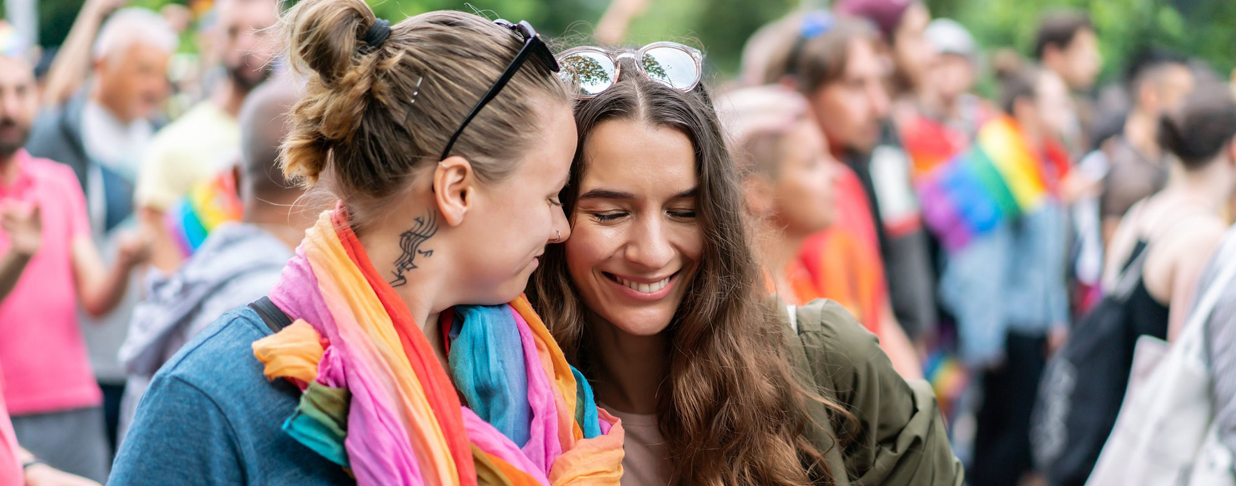Your workforce is unique, with a range of diversity across age, ethnicity and gender identity. It’s important to ensure that all your employees feel seen and heard. Not just on a professional level, but on a personal level. This includes creating safe, welcoming spaces for the valued members of the LGBTQIA+ community.
Diversity is everywhere – but the reality is, equity may not be. LGBTQIA+ individuals often do not feel supported to the level where they can embrace their authentic selves in a workplace environment.*
“It may not seem like there is a big presence of LGBTQIA+ individuals in the health care field – we’ve historically had to hide our authentic selves. But with a few simple steps we can empower everyone to give or receive best-in-class care for a beautifully diverse community.” - Dr. Andrew Neighbors
EyeMed serves as an LGBTQIA+ ally and proactive resource for clients, members and providers. We encourage you to join us in not only celebrating your LGBTQIA+ employees – but also by creating environments that facilitate diversity, equity and inclusion. The resources below are a first step in ensuring your LGBTQIA+ employees feel valued for the uniqueness they bring to your organization.
Creating a safe space for employees in the workforce
Small steps can make big strides towards inclusivity. Take the importance of pronouns, for example. Recognizing how someone identifies themselves is a simple but impactful gesture that indicates respect and acceptance. It’s what we all want and need – and it’s easy to do.
- Encourage pronoun usage and recognition by sharing yours
- Ensure data collection fields accommodate LGBTQIA+ identities
- Promote a safe and affirming environment (ex: implementing gender-neutral restrooms)
The director of the National LGBTQIA+ Health Education Center at The Fenway Institute and the Massachusetts General Hospital Psychiatry Gender Identity Program – shares the importance of LGBTQIA+ inclusive language and data collection.1
“Providing space for discussing sexual orientation and gender identity, making appropriate referrals, and encouraging family acceptance of sexual and gender minority (SGM) identities is critical for the health and well-being of children and adolescents.” - Dr. Alex S. Keuroghlian
To learn more, visit The Fenway Institute National LGBTQIA+ Health Education Center – a learning platform for HR professionals across the country. This organization can be an excellent resource for LGBTQIA+ policies that promote workplace inclusion.
Supporting diverse needs of the LBGTQIA+ workforce
Another first step towards advancing LBGTQIA+ equality is through education on diversity. It’s helpful as an employer to have sight into key issues that may fall outside of the traditional way ‘things have always been.’ Staying in-the-know about changes impacting the community is one way to be a proponent of change and take these learnings back to the workplace.
The Gay and Lesbian Medical Association helps ensure health equity for the LGBTQ+ community and equality for LGBTQ+ health professionals. The board shares that, “organization policy and position statements are an important tool in advocacy efforts to ameliorate health disparities for lesbian, gay, bisexual, transgender, and queer (LGBTQ) individuals and to improve the climate for LGBTQ health professionals.”2
The GLMA website contains resources for employers, members and providers that advocate for the following:2
- Marriage equality – help accessing insurance through a spouse to obtain health care
- Healthcare Equality Index – benchmarking tool to evaluate practices and policies
- Transgender health care – educational materials, resources and medical providers
- The GLMA Handbook on LGBT Health – takeaways to be an advocate in your company
Driving organizational change and equity
The Biden-Harris administration recently addressed the challenges in domestic health policy through the Building Better LBGTQI Health initiative. This initiative is designed to take action against stigma and structural oppression of communities that have been overlooked for centuries. As a result of discrimination, LGBTQI individuals experience elevated rates of anxiety, depression and suicide.3
As a follow-up to President Biden’s initiative, a collaboration of LGBTQI organizations – including GLMA and Fenway Health – have authored “Next Steps for Building Better LGBTQI Health.” This document provides actionable recommendations for addressing the stigma faced by those who do not identify as cisgender or heterosexual. 3
“For centuries, lesbian, gay, bisexual, transgender, queer, and intersex (LGBTQI) people have been stigmatized and subjected to systemic discrimination. This stigma and discrimination have affected health care as well as other aspects of life: LGBTQI people still encounter outright refusals of care; hostility and lack of understanding from health care providers; and a system based on heterosexual, cisgender norms that disregards their needs. As a result, LGBTQI populations suffer worse health compared to the general population.”
Read the the full proposal here.3
The good news is that we can help put an end to this completely preventable outcome, simply by exercising empathy and paying attention. Ask the question – are the specialized needs of your LBGTQ+ employees being met?
Celebrating individuality
At EyeMed, we believe in seeing the whole person. And that vision care should be unique to everyone and encompassing. With diversity, equity inclusion as top priorities for us – we believe in making everyone feel welcome. When we all come together, we create a beautiful picture worth celebrating.
Reach out to your EyeMed representative or visit eyemed.com for additional resources to create a workforce representing equality and celebrating diversity.
••••
*Dr. Andrew Neighbors, Doctor of Optometry; June 2022.
1 - “First Clinical Guidelines Published For Collecting Pediatric Sexual Orientation And Gender Identity Data;” Fenway Health; April 2022.
2 - “Advocacy;” the Gay and Lesbian Medical Association; accessed June 2022.
3 - “Next Steps for Building Back LGBTQI Health;” AIDS United, Callen-Lorde Community Health Center, Fenway Health, GLMA, Howard Brown Health, interACT: Advocates for Intersex Youth, Lyon-Martin Health Services, National Black Justice Coalition, National Center for Lesbian Rights, National Center for Transgender Equality, National LGBT Cancer Network, National LGBTQ Task Force, SAGE, Transgender Law Center, Transgender Legal Defense and Education Fund, and Whitman-Walker Institute; February 2021.
4 – “How to Offer Inclusive Care for LGBTQ+ Patients;” Review of Optometry; January 2022



